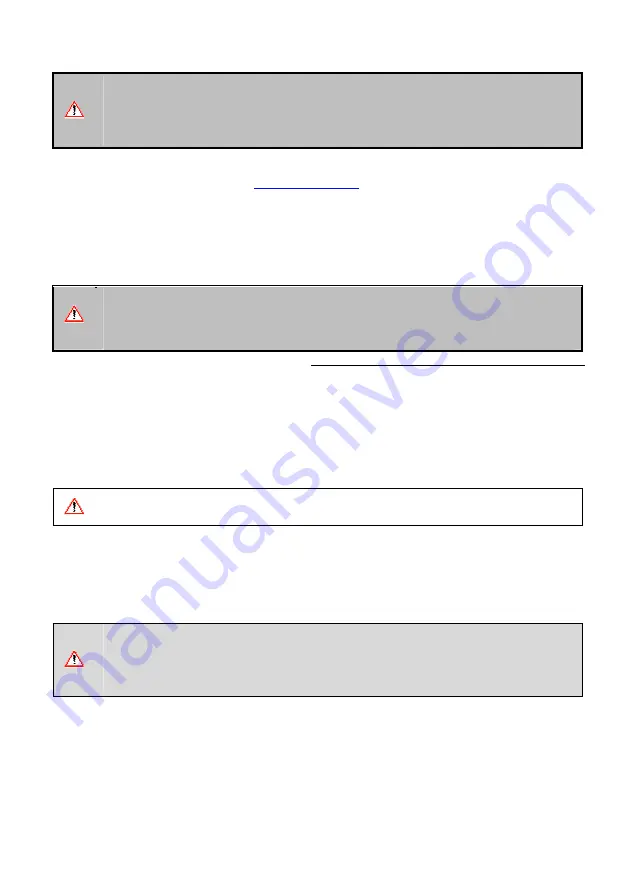
EN-3
3)
If any parts are missing, damaged or worn, replace them or tag your respirator and remove it from service.
If you notice any wear or damage, replace the damaged component if possible. If you are unable to replace
the damaged component, do not use this respirator. Remove the respirator from service, tag the unit and
return it for repair. Repairs shall only be carried out by someone familiar with the unit’s Instruction Manual
and respirator type.
Failure to replace any damaged components or the entire respirator may result in illness, injury or death.
Failure to correct anomalies can result in serious injury, illness or death.
4.2. PUTTING ON THE HEADGEAR ASSEMBLY
1)
Refer to the Instruction Manual of the Compact Air PAPR for donning procedures of those units. A copy of the Instruction
Manual is located on the Honeywell web site
www.honeywellsafety.com
.
2)
After following these instructions and when the respirator is operating properly, you are ready to put on the headgear assembly.
3)
Putting on the headgear:
a)
Slip the headgear assembly onto your head, opening up the ratchet if necessary.
b)
For PA111, pull the front of the head cover down so the elastic fits comfortably under your chin. Note that the
elastic of the PRIMAIR PLUS is located inside the hood. The end of the manifold should be positioned at the top of
your forehead.
c)
Tighten the ratchet so the headgear fits comfortably and securely.
d)
The bib of the PA111 and PA121 can be worn inside or outside of your shirt or coveralls. If the bib is too long,
connect the two (2) sets of male and female snaps located on the inside of the front bib.
The lens on the Honeywell PRIMAIR PLUS Series does not provide eye or face protection. Primary eye
protection, such as safety glasses, must also be worn in conjunction with PRIMAIR 100 Series head covers.
Failure to wear primary eye protection may result in eye injury to the worker.
Do not use the Compact Air 200 apparatus with the power turned off; a rapid build-up of carbon dioxide and
depletion of oxygen within the hood may occur.
Filters must not be fitted directly to the hood.
5. REMOVING AND CLEANING THE HEADGEAR ASSEMBLY
5.1. REMOVING THE HEADGEAR
1)
Loosen the headgear by turning the knob behind your head in an anti-clockwise direction.
2)
When the headgear has expanded, remove the head cover assembly by pulling the elastic front of the head cover up and over
your face.
3)
Remove the headgear assembly from the breathing tube by pushing down the yellow tab and twisting the breathing tube swivel
fittings from the headgear assembly.
5.2. REMOVING THE HEAD COVER FROM HEADGEAR
1)
Unsnap the two (2) snaps of the PA111 and PA121 that connect the hood to the headgear.
2)
Pull the cover back over the manifold, slipping the ratchet out through the opening.
Because the hood was exposed to contaminants during use, it is recommended that the appropriate
chemical-resistant gloves be worn while handling the head cover.
5.3. CLEANING THE HEADGEAR
1)
Clean the headgear by using a mild cleaning solution, EPI U-S 19a cleaning and disinfecting agent, and a cloth or sponge.
Rinse the headgear in clean water.
2)
Dry the headgear with a clean cloth and/or leave to air dry in a clean area.
3)
Inspect the headgear. Refer to Section “4.1. INSPECTION”.
4)
After the headgear is completely dry and has been inspected, put on a new head cover. Refer to Section “8.1. REPLACEMENT
PARTS” for a list of PRIMAIR replacement hoods. Refer to Section “3.2. ASSEMBLING THE HEAD COVER ON THE
HEADGEAR” for instructions on putting the new hood on.
Do not immerse the headgear as this may remove the lubricant in the ratchet system. If you should
inadvertently get water inside the manifold air duct, connect the headgear to your PAPR and blow air through
the air duct for several minutes to remove any traces of water. Storing or using the headgear with water
inside may damage the component, and may also result in fungal growth.
Do not use liquid solvents when cleaning the headgear. Liquid solvents may chemically weaken the plastic.
If the headgear assembly will be stored at temperatures below freezing, 0˚C, all components must be dried
thoroughly prior to storage.
5.4. REPLACING THE SWEATBAND
1)
The sweatband is held in place by a tape. Gently peel off the sweatband and discard.
2)
Use cloth wetted with isopropyl alcohol to remove any glue residue.
3)
Centre the new sweatband, P/N PA104 and press into place.






































